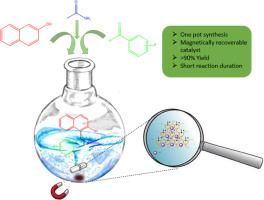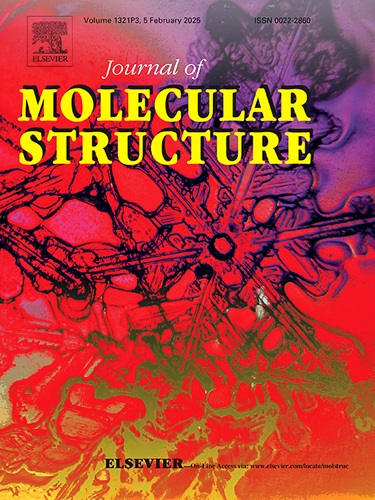Synthesis of magnetic Fe3O4@g-C3N4–SO3H composite and its application for the synthesis of α-amido alkyl-β-naphthols
IF 4
2区 化学
Q2 CHEMISTRY, PHYSICAL
引用次数: 0
Abstract
Magnetically separable g-C3N4 composite functionalized with SO3H groups (Fe3O4@g-C3N4–SO3H) was synthesized by polymerizing melamine on commercial nano Fe3O4 to prepare magnetic g-C3N4 followed by sulfonation. Catalytic activity of this composite was checked for the synthesis of fifteen α-amido alkyl-β-naphthols under solvent free conditions. The prepared catalyst exhibited excellent activity with an appreciable yield (60–93 %) in a short duration of time (15–240 min). The catalyst was active towards wide range of aromatic, heterocyclic as well as aliphatic aldehydes. The catalyst was recovered using an external magnetic field and reused for four consecutive cycles without any appreciable loss in its catalytic activity. Physical structure of the composite was studied by SEM and TEM analysis and the crystal structure by powder XRD. Surface area and porosity were determined using nitrogen adsorption-desorption via BET analysis. Elemental composition was determined by SEM-EDS and CHNS analysis. Acidity was measured using an ammonia temperature programme desorption technique and pH determination by back titration. Functional groups were studied by FTIR and thermal stability by TGA-DTA.

磁性Fe3O4@g-C3N4 -SO3H复合物的合成及其在α-氨基烷基-β-萘酚合成中的应用
采用三聚氰胺在工业纳米Fe3O4上聚合制备磁性g-C3N4并磺化,合成了SO3H官能团可磁性分离的g-C3N4复合材料(Fe3O4@g-C3N4 -SO3H)。在无溶剂条件下考察了该复合材料合成15个α-氨基烷基-β-萘酚的催化活性。所制备的催化剂表现出优异的活性,在短时间(15-240 min)内的产率(60 - 93%)可观。该催化剂对芳香族、杂环和脂肪族醛具有广泛的催化活性。使用外磁场回收催化剂,并连续重复使用四次,其催化活性没有明显损失。采用SEM和TEM分析了复合材料的物理结构,并用粉末XRD分析了复合材料的晶体结构。采用BET法测定氮的吸附-脱附比表面积和孔隙率。元素组成通过SEM-EDS和CHNS分析测定。酸度用氨温程序解吸法测定,pH值用反滴定法测定。用红外光谱(FTIR)和热稳定性分析(TGA-DTA)研究了官能团。
本文章由计算机程序翻译,如有差异,请以英文原文为准。
求助全文
约1分钟内获得全文
求助全文
来源期刊

Journal of Molecular Structure
化学-物理化学
CiteScore
7.10
自引率
15.80%
发文量
2384
审稿时长
45 days
期刊介绍:
The Journal of Molecular Structure is dedicated to the publication of full-length articles and review papers, providing important new structural information on all types of chemical species including:
• Stable and unstable molecules in all types of environments (vapour, molecular beam, liquid, solution, liquid crystal, solid state, matrix-isolated, surface-absorbed etc.)
• Chemical intermediates
• Molecules in excited states
• Biological molecules
• Polymers.
The methods used may include any combination of spectroscopic and non-spectroscopic techniques, for example:
• Infrared spectroscopy (mid, far, near)
• Raman spectroscopy and non-linear Raman methods (CARS, etc.)
• Electronic absorption spectroscopy
• Optical rotatory dispersion and circular dichroism
• Fluorescence and phosphorescence techniques
• Electron spectroscopies (PES, XPS), EXAFS, etc.
• Microwave spectroscopy
• Electron diffraction
• NMR and ESR spectroscopies
• Mössbauer spectroscopy
• X-ray crystallography
• Charge Density Analyses
• Computational Studies (supplementing experimental methods)
We encourage publications combining theoretical and experimental approaches. The structural insights gained by the studies should be correlated with the properties, activity and/ or reactivity of the molecule under investigation and the relevance of this molecule and its implications should be discussed.
 求助内容:
求助内容: 应助结果提醒方式:
应助结果提醒方式:


